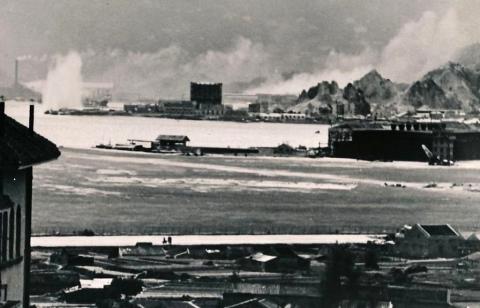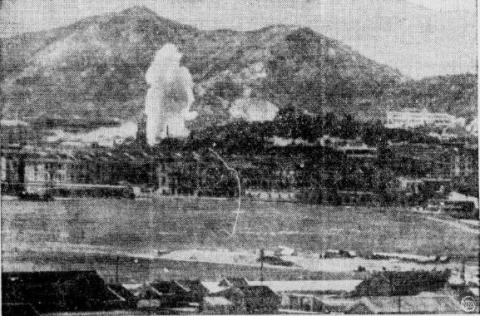The aircraft descended on an initial heading of North-East. This took the plane over the harbour and then over west Kowloon. This part of the approach was done with an instrument guidance system. Passengers who had not been to HK before found this quite thrilling, as they got their first views of the place, but they were unprepared for what happened next...
The final part of the approach was necessarily done visually.
You flew up to the "chequerboard", two miles from touchdown, and at six hundred and fifty feet you turned Right 47 degrees, like this: 
not like this....
You exited the turn at 140 feet and lined up for the runway, avoiding collecting any washing lines on the wing tips...
Here is a local, doing it properly...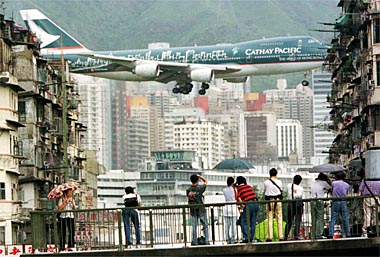
whilst coming from the east, to land on Runway 31, you lined up over the harbour, avoiding the characteristic "midstreaming" container lighters with their large derricks, but keeping in mind that a go round that failed to avoid Lion Rock could spoil your whole day... (it happened)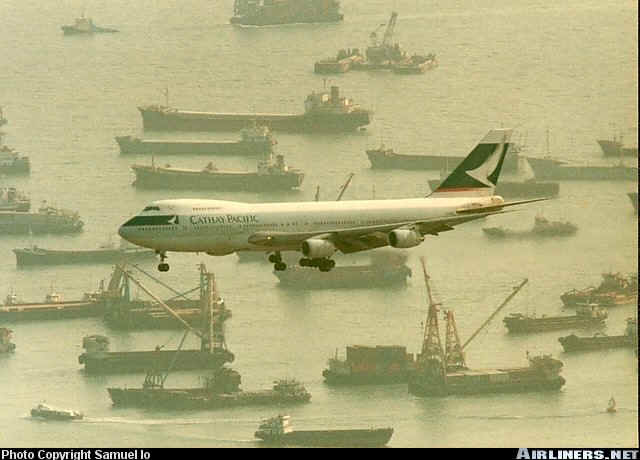
You were meant to touch down on the wheels, not the port outer engine...(this was a common mishap, caused by not flying right up to the chequerboard, which meant that you were too far to the South when you lined up the runway - the Hong Kong Aircraft Engineering Company did quite well out of engine strikes) 
and you were meant to land on the runway...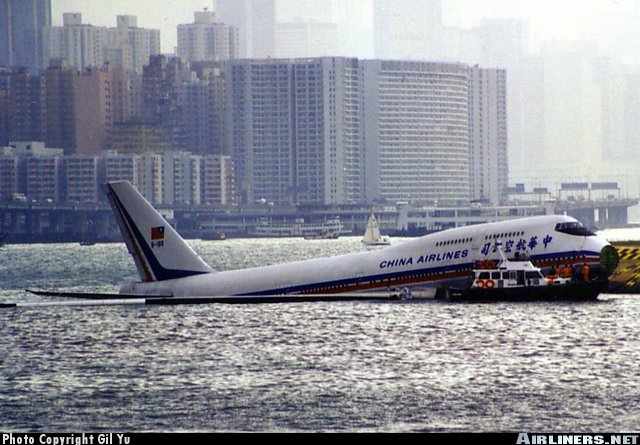
Here's a cockpit video of the approach to 13, taken near the final days of Kai Tak from, I think, CX 250 (a 747 from London)
Personally I made it a rule always to fly Cathay Pacific, on the grounds that all their pilots lived in Hong Kong (company rule) and therefore they got lots of practice!
Now, I think we need a picture of Sir Kai Ho (note he was very Anglicised and reversed his name so that his surname came last in the Western manner - his family name was Ho:

and Mr Au Tak:

both of whom formed a company to reclaim land for housing on the Kowloon side of the harbour, but they both died before the project was finished and the company went into liquidation, which gave the Government an opportunity to buy the reclaimed land as a seaplane base.
The land reclaimed by these two gentlemen was not of course the long runway extending into the harbour; that was built to take jets, in the later 1950's.
The original Kai Tak Airfield was a grass runway; used by the RAF and to a very limited extent by commercial aviation.
My friend Freddie Clemo recalled seeing the start of Japanese attack on Hong Kong; he was serving in the Hong Kong Volunteer Defence Corps and on the morning of Pearl Harbour he was sailing in the harbour with a girlfriend when he saw the first wave of Japanese aircraft come over with unfriendly intent,
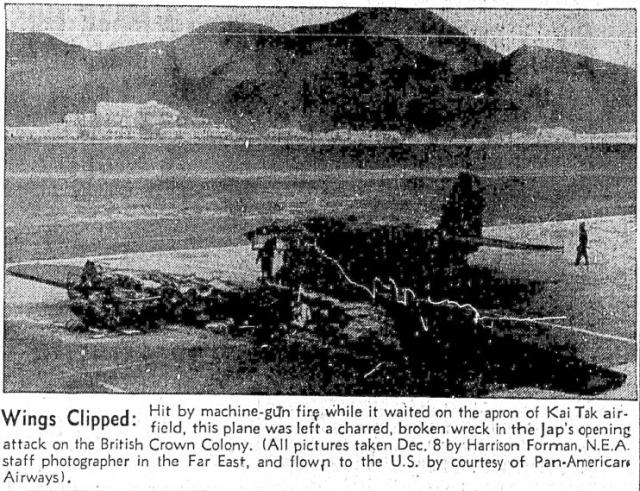
From Winnipeg Tribune, 17 Jan 1942
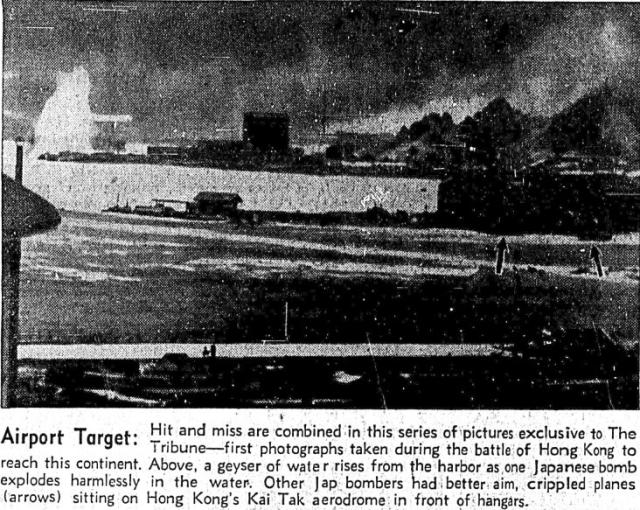
From Winnipeg Tribune, 17 Jan 1942
Comments
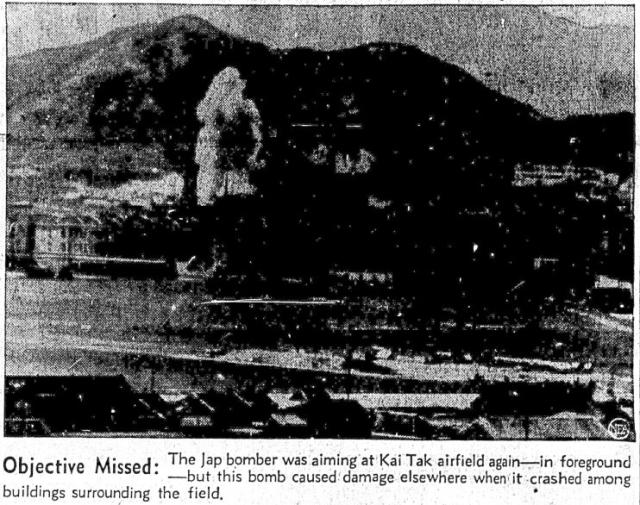
From Winnipeg Tribune, 17 Jan 1942
Comments
He was stationed at the airfield and he got there as fast as he could, just in time to see the RAF pilots of the five biplanes stationed there "scramble" for their planes for the next wave - rather unsucessfully, according to Freddie, because the standard RAF parachute of the day hung down behind you and you could not run fast wearing it, so most of the planes were taken out on the ground.
More of Freddie's recollections of the Battle of Hong Kong later.
The Japanese developed the airfield, (well, it would be more correct to say that Allied prisoners of war working for the Japanese developed the airfield) concreting two runways, old 13/31` and 7/25
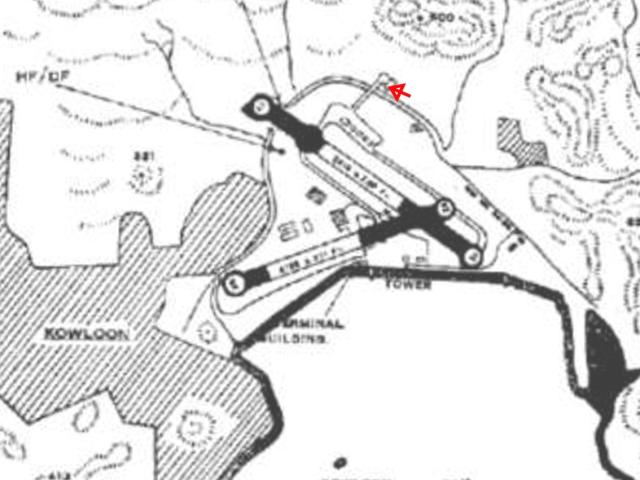
Original source unknown.
The red arrow is pointing to the old RAF hangar which as you can see is the wrong side of the road. The road had to be closed to fly off or land on 13/31 as you can see. This whole area was the apron in the later days of Kai Tak.
In this 1957 map the old runways are about to go out of use and the new 7,200 feet 13/31 is about to be commissioned:
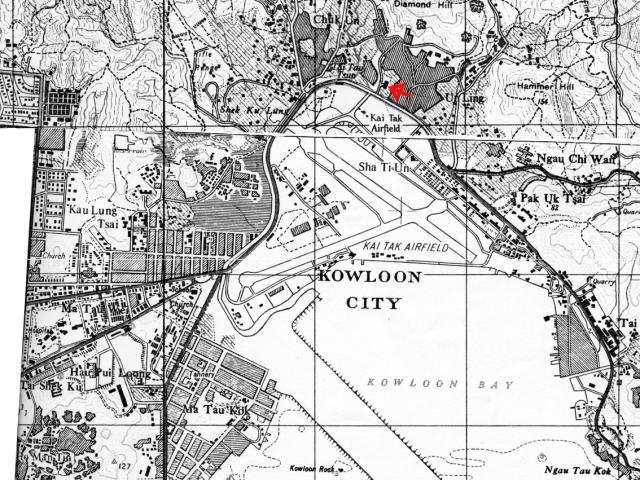
Comments
Hi there,
'seeing the start of Japanese attack on Hong Kong; he was serving in the Hong Kong Regiment (a TA unit, of course)'
The first regiment named "Hong Kong Regiment" was disbanded in 1909 and the second so named was formed in 1949.
The unit was 'Hong Kong Volunteer Defence Corps', a local colonial unit.
Regards,
isdl
ref: http://www.hongkongwardiary.com/
An entry from Dec 8th, 1941 in Not the Slightest Chance describes the first air raid by the Japanese:
8am: A dozen Japanese Ki36 bombers of the 45th Sentai escorted by nine Ki 27 fighters of the 10th Independent Chutai, operating from Guang Zhou, approach Kai Tak from the west in a V formation. They machine-gun and dive-bomb the barrack blocks and the RAF's three dispersed Vicker Vildebeeste torpedo bombers. They then attack the two surviving Supermarine Walrus amphibians and sink them both. 'Both Walrus are gone, one Beeste is ablaze, another badly damaged, leaving one plane intact.'
Hello
My late father (an RAF pilot who was a Transport Command Pilot Examiner for several years) had a tale to tell about one rather memorable approach to Kai Tak. The story is here: http://www.burningblue.co.za/flying-stories/a-sprig-of-the-aristocracy
As far as I can make out this would have been before the building of runways 13/31 - these were built in 1957 and he was an examiner from 1953 to 1955. Does anyone know what direction they would have approached from and whereabouts this might have happened? I suppose the narrow miss could have been the checkerboard, but from Dad's account it sounds as though this happened much earlier in the approach and they came in across the island from the West.
The aircraft would have been a Handley Page Hastings. I imagine the let-down would have started from a much lower altitude than for a modern jet.
Many thanks in advance for any information,
Caroline
Hi there Caroline,
Very interesting account of a near accident in Kai Tak. From reading the page you linked to, the second video showing simulator footage shows an airport that is not Kai Tak. It is the new airport in Hong Kong in use since 1998. The terrain shown there is of Lantau Island, with taller mountains than Kai Tak but nowhere near as close to the runway.
From the text, it looks as if the turn to starboard was done to avoid the Lion Rock, part of the wall of mountains that divides Kowloon in the South from the New Territories to the North. If I understand it right, then your father would have made the second half of the landing as shown in video one, starting with the sharp life-saving turn. That most likely meant the plane approached Kowloon from the Southwest, turned at the beacon and faced southeast to land.
Kai Tak Airport history can be viewed here:http://gwulo.com/kai-tak-airport-history
Post war Kai Tak till 1958 had two crossing runways 07/25 and 13/31. There were two instrument let-down approaches, one via Cheung Chau (from the south-west) and the other via Waglan and Lyemun Gap (from the south-east) followed by a final visual segment of flight to land.
In 1950s Kai Tak. there was no Checkerboard Hill. Presently, there are no youtube videos of the approaches to Kai Tak before the opening of the reclaimed runway 13/31 in 1958.
From the story that you have provided and considering the aircraft type mentioned, it is quite likely that the flight was making an approach to the longer runway i.e. runway 13 as seen here:http://gwulo.com/node/1841
Many thanks for the comments and information (and apologies for the delay in replying). I've removed the 2nd video and added a link to this page.
Moddsey, any idea what sort of instrument guidance system they would have had in those days? I think the Hastings (which came into service during the Berlin Airlift) was one of the early recipients of BABS (Blind Approach Beacon System) which sounds like a precursor to modern IGS systems, but using it depended on whether the airfield had a radio beacon(s), and they flew into a lot of places which weren't equipped & relied on ATC to talk them down if they had to do a ground-controlled approach. I don't think it was much more than a radio path that the pilot could follow to help him locate and stay on the approach path.
regards
Caroline
The Instrument Guidance System on Checker Board Hill was installed in 1974.
In the early 1950s, I think, one would be looking at instrument let-down approaches through use of radio beacons e.g. non-directional radio beacon (NDB) at Cheung Chau where aircraft would be descending in a tear-drop holding pattern until subsequent visual flight could be executed and maintained.
Have a look of the approach via Cheung Chau from the 1960s to the reclaimed runway at Kai Tak at:
Many thanks, Moddsey, those are fabulous! I'll post them under the story.
Judging by when they put the flaps down, most of the fun was on the final approach. You can certainly see why not turning to starboard would be a bit of a problem!
I'm hoping to get the UK early next year (I'm in Cape Town) and am hoping to visit one of Dad's best mates from XXIV Squadron and later Aden. He flew the Hastings as well and will almost certainly have done Changi - Kai Tak several times, so may well have some interesting info to contribute.
regards
Caroline
Hastings at Kai Tak in the 1950s. Click on this link
My late uncle flew Hastings out of Singapore, presumably where this example was based, in the 1950s. They were frequent visitors to Kai Tak. A number of Hastings are among the interesting aircraft visible at Kai Tak in the iconic 1950s "Air Hostess" colour movie, now widely available on VCD. Never mind the "plot", watch the planes!
In the recently published UK magazine AEROPLANE (February 2011 edition) there is an article on a particular RAF Handley Page Hastings named IDRIS 11. This article mentions a recently discovered “lost” 30 minute 1955 British Pathe “Recruitment” colour film depicting a journey in an RAF Hastings from the UK to Singapore and Hong Kong stopping at various RAF stations in between. The Kai Tak portion at the end apparently depicts long forgotten RAF de Havilland Hornets and RAF Marine Craft. No doubt the magazine’s editor could put anyone interested in contact with the article’s author who may reveal how the film can be seen, although I believe some British Pathe material can be viewed on-line. AEROPLANE has a website www.aeroplanemonthly.com
